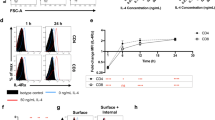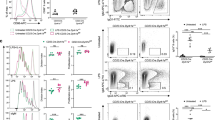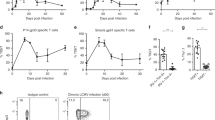Abstract
Immunoglobulin class switching from immunoglobulin M (IgM) to IgG and IgA is central to immunity against viruses and requires the activation of B cells by T cells via CD154 (CD40 ligand) and cytokines. These molecules limit their signaling activity in immune cells by turning on negative feedback proteins, including IκB and SOCS. We show here that negative factor (Nef) protein, an immunosuppressive human immunodeficiency virus 1 protein expressed and released by infected cells, penetrates B cells both in vivo and in vitro. Nef suppressed immunoglobulin class-switch DNA recombination by inducing IκBα and SOCS proteins, which blocked CD154 and cytokine signaling via NF-κB and STAT transcription factors. Thus, human immunodeficiency virus 1 may evade protective T cell–dependent IgG and IgA responses by 'hijacking' physiological feedback inhibitors in B cells via Nef.
This is a preview of subscription content, access via your institution
Access options
Subscribe to this journal
Receive 12 print issues and online access
$209.00 per year
only $17.42 per issue
Buy this article
- Purchase on Springer Link
- Instant access to full article PDF
Prices may be subject to local taxes which are calculated during checkout







Similar content being viewed by others
References
Pantaleo, G. & Fauci, A.S. New concepts in the immunopathogenesis of HIV infection. Annu. Rev. Immunol. 13, 487–512 (1995).
Lane, H.C. et al. Abnormalities of B-cell activation and immunoregulation in patients with the acquired immunodeficiency syndrome. N. Engl. J. Med. 309, 453–458 (1983).
Stavnezer, J. Antibody class switching. Adv. Immunol. 61, 79–146 (1996).
MacLennan, I.C. Germinal centers. Annu. Rev. Immunol. 12, 117–139 (1994).
Manis, J.P., Tian, M. & Alt, F.W. Mechanism and control of class-switch recombination. Trends Immunol. 23, 31–39 (2002).
Honjo, T., Kinoshita, K. & Muramatsu, M. Molecular mechanism of class switch recombination: linkage with somatic hypermutation. Annu. Rev. Immunol. 20, 165–196 (2002).
Pantaleo, G. et al. Lymphoid organs function as major reservoirs for human immunodeficiency virus. Proc. Natl. Acad. Sci. USA 88, 9838–9842 (1991).
Moir, S. et al. Perturbations in B cell responsiveness to CD4+ T cell help in HIV-infected individuals. Proc. Natl. Acad. Sci. USA 100, 6057–6062 (2003).
Morris, L. et al. HIV-1 antigen-specific and -nonspecific B cell responses are sensitive to combination antiretroviral therapy. J. Exp. Med. 188, 233–245 (1998).
Moir, S. et al. B cells of HIV-1-infected patients bind virions through CD21-complement interactions and transmit infectious virus to activated T cells. J. Exp. Med. 192, 637–646 (2000).
Ravanel, K. et al. Measles virus nucleocapsid protein binds to FcγRII and inhibits human B cell antibody production. J. Exp. Med. 186, 269–278 (1997).
Guy, B. et al. HIV F/3′ ORF encodes a phosphorylated GTP-binding protein resembling an oncogene product. Nature 330, 266–269 (1987).
Fujii, Y., Otake, K., Tashiro, M. & Adachi, A. Soluble Nef antigen of HIV-1 is cytotoxic for human CD4+ T cells. FEBS Lett. 393, 93–96 (1996).
Cullen, B.R. HIV-1 auxiliary proteins: making connections in a dying cell. Cell 93, 685–692 (1998).
Kestler, H.W., III et al. Importance of the nef gene for maintenance of high virus loads and for development of AIDS. Cell 65, 651–662 (1991).
Deacon, N.J. et al. Genomic structure of an attenuated quasi species of HIV-1 from a blood transfusion donor and recipients. Science 270, 988–991 (1995).
Blagoveshchenskaya, A.D., Thomas, L., Feliciangeli, S.F., Hung, C.H. & Thomas, G. HIV-1 Nef downregulates MHC-I by a PACS-1- and PI3K-regulated ARF6 endocytic pathway. Cell 111, 853–866 (2002).
Collins, K.L., Chen, B.K., Kalams, S.A., Walker, B.D. & Baltimore, D. HIV-1 Nef protein protects infected primary cells against killing by cytotoxic T lymphocytes. Nature 391, 397–401 (1998).
Garcia, J.V. & Miller, A.D. Serine phosphorylation-independent downregulation of cell-surface CD4 by nef. Nature 350, 508–511 (1991).
Pope, M. et al. Conjugates of dendritic cells and memory T lymphocytes from skin facilitate productive infection with HIV-1. Cell 78, 389–398 (1994).
Swingler, S. et al. HIV-1 Nef mediates lymphocyte chemotaxis and activation by infected macrophages. Nat. Med. 5, 997–1003 (1999).
Swingler, S. et al. HIV-1 Nef intersects the macrophage CD154 signalling pathway to promote resting-cell infection. Nature 424, 213–219 (2003).
Baur, A.S. et al. HIV-1 Nef leads to inhibition or activation of T cells depending on its intracellular localization. Immunity 1, 373–384 (1994).
Kuster, H. et al. Treatment-induced decline of human immunodeficiency virus-1 p24 and HIV-1 RNA in lymphoid tissue of patients with early human immunodeficiency virus-1 infection. Am. J. Pathol. 156, 1973–1986 (2000).
Brigino, E. et al. Interleukin 10 is induced by recombinant HIV-1 Nef protein involving the calcium/calmodulin-dependent phosphodiesterase signal transduction pathway. Proc. Natl. Acad. Sci. USA 94, 3178–3182 (1997).
Federico, M. et al. HIV-1 Nef activates STAT1 in human monocytes/macrophages through the release of soluble factors. Blood 98, 2752–2761 (2001).
Quaranta, M.G., Tritarelli, E., Giordani, L. & Viora, M. HIV-1 Nef induces dendritic cell differentiation: a possible mechanism of uninfected CD4+ T cell activation. Exp. Cell Res. 275, 243–254 (2002).
Olivetta, E. et al. HIV-1 Nef induces the release of inflammatory factors from human monocyte/macrophages: involvement of Nef endocytotic signals and NF-κB activation. J. Immunol. 170, 1716–1727 (2003).
Varin, A. et al. Exogenous Nef protein activates NF-κB, AP-1, and c-Jun N-terminal kinase and stimulates HIV transcription in promonocytic cells. Role in AIDS pathogenesis. J. Biol. Chem. 278, 2219–2227 (2003).
James, C.O. et al. Extracellular Nef protein targets CD4+ T cells for apoptosis by interacting with CXCR4 surface receptors. J. Virol. 78, 3099–3109 (2004).
Rubartelli, A., Poggi, A., Sitia, R. & Zocchi, M.R. HIV-I Tat: a polypeptide for all seasons. Immunol. Today 19, 543–545 (1998).
Lefevre, E.A., Krzysiek, R., Loret, E.P., Galanaud, P. & Richard, Y. Cutting edge: HIV-1 Tat protein differentially modulates the B cell response of naive, memory, and germinal center B cells. J. Immunol. 163, 1119–1122 (1999).
He, B., Qiao, X. & Cerutti, A. CpG DNA induces IgG class switch DNA recombination by activating human B cells through an innate pathway that requires TLR9 and cooperates with IL-10. J. Immunol. 173, 4479–4491 (2004).
Peng, B. & Robert-Guroff, M. Deletion of N-terminal myristoylation site of HIV Nef abrogates both MHC-1 and CD4 down-regulation. Immunol. Lett. 78, 195–200 (2001).
Geyer, M., Fackler, O.T. & Peterlin, B.M. Structure–function relationships in HIV-1 Nef. EMBO Rep. 2, 580–585 (2001).
Litinskiy, M.B. et al. DCs induce CD40-independent immunoglobulin class switching through BLyS and APRIL. Nat. Immunol. 3, 822–829 (2002).
Stumptner-Cuvelette, P. et al. HIV-1 Nef impairs MHC class II antigen presentation and surface expression. Proc. Natl. Acad. Sci. USA 98, 12144–12149 (2001).
Chaudhry, A. et al. The Nef protein of HIV-1 induces loss of cell surface costimulatory molecules CD80 and CD86 in APCs. J. Immunol. 175, 4566–4574 (2005).
Ghosh, S. & Karin, M. Missing pieces in the NF-κB puzzle. Cell 109, S81–S96 (2002).
Karin, M. & Ben-Neriah, Y. Phosphorylation meets ubiquitination: the control of NF-κB activity. Annu. Rev. Immunol. 18, 621–663 (2000).
Lee, S.B., Park, J., Jung, J.U. & Chung, J. Nef induces apoptosis by activating JNK signaling pathway and inhibits NF-κB-dependent immune responses in Drosophila. J. Cell Sci. 118, 1851–1859 (2005).
Geha, R.S., Jabara, H.H. & Brodeur, S.R. The regulation of immunoglobulin E class-switch recombination. Nat. Rev. Immunol. 3, 721–732 (2003).
Leonard, W.J. & O'Shea, J.J. Jaks and STATs: biological implications. Annu. Rev. Immunol. 16, 293–322 (1998).
Alexander, W.S. & Hilton, D.J. The role of suppressors of cytokine signaling (SOCS) proteins in regulation of the immune response. Annu. Rev. Immunol. 22, 503–529 (2004).
Burton, D.R. Antibodies, viruses and vaccines. Nat. Rev. Immunol. 2, 706–713 (2002).
Fagarasan, S. & Honjo, T. Intestinal IgA synthesis: regulation of front-line body defences. Nat. Rev. Immunol. 3, 63–72 (2003).
Watkins, S.C. & Salter, R.D. Functional connectivity between immune cells mediated by tunneling nanotubules. Immunity 23, 309–318 (2005).
Poudrier, J. et al. The AIDS disease of CD4C/HIV transgenic mice shows impaired germinal centers and autoantibodies and develops in the absence of IFN-γ and IL-6. Immunity 15, 173–185 (2001).
Hanada, T. et al. Suppressor of cytokine signaling-1 is essential for suppressing dendritic cell activation and systemic autoimmunity. Immunity 19, 437–450 (2003).
Geyer, M. & Peterlin, B.M. Domain assembly, surface accessibility and sequence conservation in full length HIV-1 Nef. FEBS Lett. 496, 91–95 (2001).
Acknowledgements
We thank J.P. Moore and K.A. Smith (Weill Medical College of Cornell University, New York) for discussions. Supported by the National Institutes of Health (AI057530 and AI057653 to A.C.).
Author information
Authors and Affiliations
Corresponding author
Ethics declarations
Competing interests
The authors declare no competing financial interests.
Supplementary information
Supplementary Fig. 1
p17 does not penetrate in B cells in vivo. (PDF 823 kb)
Supplementary Fig. 2
Low concentrations of Nef are sufficient to enter B cells and inhibit TD CSR and Ig secretion. (PDF 101 kb)
Supplementary Fig. 3
Low concentrations of Nef are sufficient to inhibit CD40 signaling through NF-κB and IL-4 signaling through STAT6 in B cells. (PDF 181 kb)
Supplementary Fig. 4
Nef suppresses TD CSR and antibody production in bystander B cells. (PDF 146 kb)
Rights and permissions
About this article
Cite this article
Qiao, X., He, B., Chiu, A. et al. Human immunodeficiency virus 1 Nef suppresses CD40-dependent immunoglobulin class switching in bystander B cells. Nat Immunol 7, 302–310 (2006). https://doi.org/10.1038/ni1302
Received:
Accepted:
Published:
Issue Date:
DOI: https://doi.org/10.1038/ni1302
This article is cited by
-
Impact of HIV-1 Vpr manipulation of the DNA repair enzyme UNG2 on B lymphocyte class switch recombination
Journal of Translational Medicine (2020)
-
Antibody-based therapeutic interventions: possible strategy to counter chikungunya viral infection
Applied Microbiology and Biotechnology (2020)
-
Rapid decrease in titer and breadth of neutralizing anti-HCV antibodies in HIV/HCV-coinfected patients who achieved SVR
Scientific Reports (2019)
-
HIV-1 Nef-induced lncRNA AK006025 regulates CXCL9/10/11 cluster gene expression in astrocytes through interaction with CBP/P300
Journal of Neuroinflammation (2018)
-
Viral subversion of B cell responses within secondary lymphoid organs
Nature Reviews Immunology (2018)



